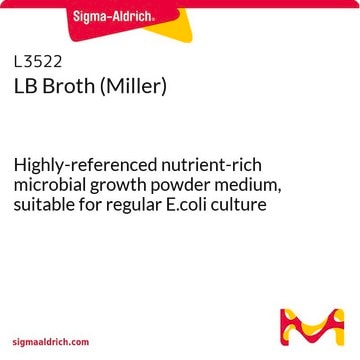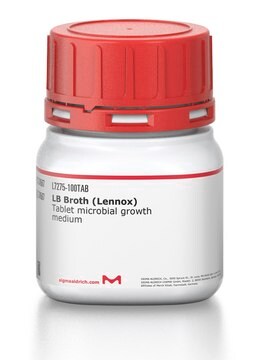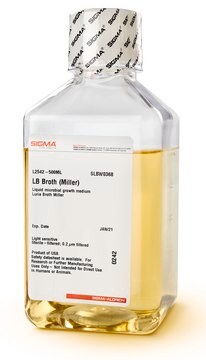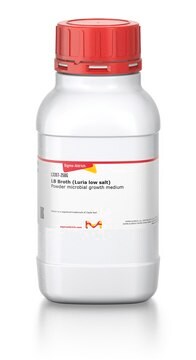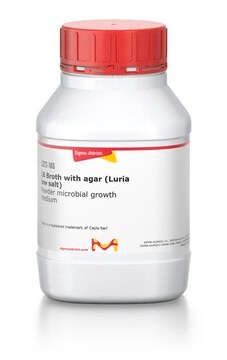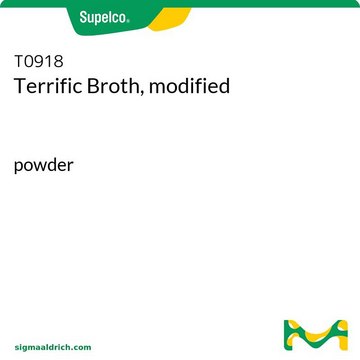L7658
LB Broth (Lennox)
EZMix powder microbial growth medium
Synonym(s):
Lennox broth
Sign Into View Organizational & Contract Pricing
All Photos(2)
About This Item
UNSPSC Code:
41106200
NACRES:
NA.85
Recommended Products
grade
for molecular biology
Quality Level
description
quick-dissolve, dust-free formulation
sterility
non-sterile
form
powder
technique(s)
microbiological culture: suitable
pH
6.8-7.2(2.5% solution)
application(s)
agriculture
food and beverages
microbiology
storage temp.
room temp
suitability
nonselective for Escherichia coli
nonselective for coliforms
General description
Lennox LB is a highly-referenced microbial growth medium used for the cultivation of E. coli. This nutrient-rich microbial broth contains peptides, amino acids, water-soluble vitamins, and carbohydrates in a low-salt formulation.
Application
Suitable for non-selective cultivation of E. coli strains for cloning, DNA plasmid production and production of recombinant proteins. Also suitable for selective cultivation when appropriate antibiotics are added, including those that require low-salt conditions, such as Zeocin®.
Features and Benefits
Lennox LB EZMix powder provides:
- Granulated, dust-free format for safer handling and faster mixing
- Convenient small package to eliminate weighing
- Easy scale-up using larger package sizes
- Standard formulation
Components
*Note some of the product sizes available are given in liquid measure. This is a powder format product and those sizes reflect the final reconstituted volume.
10g/L Tryptone
5 g/L Yeast Extract
5 g/L NaCl
0.6 g/L inert binder (EZMix formulation only)
10g/L Tryptone
5 g/L Yeast Extract
5 g/L NaCl
0.6 g/L inert binder (EZMix formulation only)
Preparation Note
1. Suspend 20.6 g in 1 L of distilled water.
2. Autoclave for 15 minutes at 121 °C.
To prepare Lennox L Broth: Add 1 g glucose and proceed with preparation instructions as above.
To prepare the medium of Enquist and Sternberg: Aseptically add 10 ml of sterile 1M magnesium sulfate after autoclaving.
2. Autoclave for 15 minutes at 121 °C.
To prepare Lennox L Broth: Add 1 g glucose and proceed with preparation instructions as above.
To prepare the medium of Enquist and Sternberg: Aseptically add 10 ml of sterile 1M magnesium sulfate after autoclaving.
Reconstitution
Stir to suspend 20.6g powder in 1L water. Autoclave for 15 minutes at 121°C to sterilize. Allow to cool before making additions, such as antibiotics (if desired).
Legal Information
Zeocin is a registered trademark of Cayla Sarl
related product
Product No.
Description
Pricing
Storage Class Code
11 - Combustible Solids
WGK
WGK 2
Flash Point(F)
Not applicable
Flash Point(C)
Not applicable
Choose from one of the most recent versions:
Already Own This Product?
Find documentation for the products that you have recently purchased in the Document Library.
Customers Also Viewed
Jennifer White et al.
Protein science : a publication of the Protein Society, 13(9), 2406-2415 (2004-08-24)
Decay-accelerating factor (DAF, CD55) is a glycophosphatidyl inositol-anchored glycoprotein that regulates the activity of C3 and C5 convertases. In addition to understanding the mechanism of complement inhibition by DAF through structural studies, there is also an interest in the possible
Katherine A Kantardjieff et al.
Acta crystallographica. Section D, Biological crystallography, 60(Pt 5), 895-902 (2004-04-23)
The Mycobacterium tuberculosis rmlC gene encodes dTDP-4-keto-6-deoxyglucose epimerase, the third enzyme in the M. tuberculosis dTDP-L-rhamnose pathway which is essential for mycobacterial cell-wall synthesis. Because it is structurally unique, highly substrate-specific and does not require a cofactor, RmlC is considered
Michael C Konopka et al.
Journal of bacteriology, 188(17), 6115-6123 (2006-08-23)
The first in vivo measurements of a protein diffusion coefficient versus cytoplasmic biopolymer volume fraction are presented. Fluorescence recovery after photobleaching yields the effective diffusion coefficient on a 1-mum-length scale of green fluorescent protein within the cytoplasm of Escherichia coli
Alexis Kaushansky et al.
Nature protocols, 5(4), 773-790 (2010-04-03)
Protein microarrays provide an efficient way to identify and quantify protein-protein interactions in high throughput. One drawback of this technique is that proteins show a broad range of physicochemical properties and are often difficult to produce recombinantly. To circumvent these
Feng Xu et al.
PloS one, 6(4), e19344-e19344 (2011-05-10)
Decellularization and cellularization of organs have emerged as disruptive methods in tissue engineering and regenerative medicine. Porous hydrogel scaffolds have widespread applications in tissue engineering, regenerative medicine and drug discovery as viable tissue mimics. However, the existing hydrogel fabrication techniques
Protocols
General protocols for growth of competent cells in microbial medium.
Our team of scientists has experience in all areas of research including Life Science, Material Science, Chemical Synthesis, Chromatography, Analytical and many others.
Contact Technical Service
